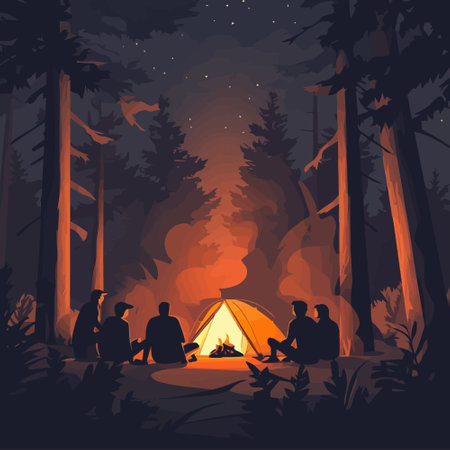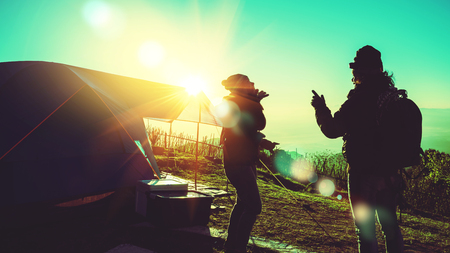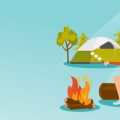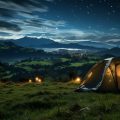1. Determine Your Camping Style
Before you dive into campsite reservations or start packing your gear, it’s important to figure out what kind of camping experience you want. Choosing the right style will help you narrow down the best locations and ensure you’re fully prepared for your trip.
What Are the Main Types of Camping?
There are several popular camping styles in the U.S., and each offers a different level of comfort, adventure, and accessibility. Heres a quick breakdown:
| Camping Style | Description | Best For |
|---|---|---|
| Car Camping | You drive right up to your campsite. Tents are usually set up near your vehicle. Amenities like restrooms, fire pits, and picnic tables are often available. | Beginners, families, casual weekend trips |
| Backcountry Camping | You hike into remote areas with all your gear on your back. There are no facilities—just nature and solitude. | Experienced campers, adventure seekers, those wanting a true escape |
| RV Camping | You camp in a recreational vehicle with many comforts of home. Sites may have electricity, water hookups, and even Wi-Fi. | Comfort lovers, road trippers, long-term travelers |
Why This Decision Matters
Your choice affects everything—from the gear you need to pack to the type of campsite you’ll book. For example, if youre car camping, youll want a drive-in site with parking access. If youre going backcountry, youll need a permit and navigation skills. RV campers should look for campgrounds with hookup options and easy access roads.
Ask Yourself These Questions:
- How much gear am I comfortable carrying?
- Do I want amenities like restrooms and showers?
- Am I looking for convenience or adventure?
- What’s my experience level with camping?
Pro Tip:
If it’s your first time camping, car camping is usually the easiest way to ease into outdoor life without giving up too many comforts.
2. Research Public vs. Private Campgrounds
Before booking your first campsite, it’s important to understand the different types of campgrounds available in the U.S. Each one offers unique experiences, amenities, and rules. Knowing the pros and cons of public versus private campgrounds can help you choose the one that fits your needs best.
Public Campgrounds
Public campgrounds are run by government agencies like the National Park Service, state park systems, or the Bureau of Land Management (BLM). These sites are often located in scenic natural areas and provide a more rustic camping experience.
Types of Public Campgrounds:
- National Parks: Famous for stunning landscapes and protected wildlife. Examples include Yellowstone and Yosemite.
- State Parks: Managed by individual states; usually less crowded than national parks but still offer great nature access.
- BLM Land: Typically found in the western U.S., these are vast open lands where dispersed camping is allowed with minimal facilities.
Main Features of Public Campgrounds:
| Type | Accessibility | Amenities | Reservation Policy |
|---|---|---|---|
| National Parks | High demand, may require advance booking months ahead | Restrooms, picnic tables, fire rings, visitor centers | Online reservations via Recreation.gov; some walk-ins |
| State Parks | Easier to book than national parks; good for beginners | Showers, electric hookups, camp stores (varies by park) | State-specific reservation websites; limited walk-ins |
| BLM Land | No reservations needed; remote and open access | Very limited or no amenities; primitive camping only | First-come, first-served; free or low-cost permits may apply |
Private Campgrounds
Privately owned campgrounds—like KOA or independent RV parks—offer a more comfortable and convenient experience. They’re usually closer to towns or highways and cater to families, RV travelers, and first-time campers looking for extra services.
Main Features of Private Campgrounds:
- Full-service amenities: Wi-Fi, laundry rooms, showers, pools, playgrounds
- Easier reservations through campground websites or phone calls
- Often more expensive but provide a hassle-free experience
- Great for social activities and traveling with kids or pets
Comparison at a Glance:
| Public Campgrounds | Private Campgrounds | |
|---|---|---|
| Accessibility | Might be remote or require early planning | Easily accessible by car; near major roads/towns |
| Amenities | Basic to moderate (depends on location) | Full-service (Wi-Fi, showers, electric hookups) |
| Cost | $0–$30 per night typically (lower cost) | $30–$70+ per night (higher cost) |
| Booking Process | Mainly online with federal/state systems; may need to book early | User-friendly websites or phone booking; flexible cancellation policies |
Which One Is Right for You?
If youre looking for peace and nature with fewer distractions, public campgrounds might be ideal. But if you prefer convenience, comfort, and amenities—especially if youre camping with kids—private campgrounds could be the better choice. Consider what kind of experience you want for your first trip before making a decision.
Selecting the right type of campground is a key step in planning a successful first camping trip. Whether you go public or private depends on your comfort level, expectations, and how much planning youre ready to do.

3. Check Accessibility and Travel Distance
Before picking your first campsite, it’s important to think about how far youre willing to travel and how easy it is to get there. A remote mountain spot might sound exciting, but if the roads are rough or require a 4×4 vehicle, it could turn into a stressful trip—especially for beginners.
How Far Are You Willing to Drive?
Start by deciding how many hours you’re comfortable driving. Long road trips can be fun, but they can also be tiring. Keep in mind the time needed to set up camp once you arrive. If youre only going for a weekend, staying within 1–3 hours from home might be best.
Travel Time vs. Trip Length
| Trip Length | Recommended Driving Time (One Way) |
|---|---|
| Weekend Getaway | 1–3 hours |
| Long Weekend (3-4 days) | 3–5 hours |
| Weeklong Adventure | 5+ hours |
Check Road Conditions
Not all campsites are located off smooth highways. Some may require driving on dirt roads or steep inclines. Always check current road conditions online or call the local ranger station. Wet weather can make unpaved roads muddy and hard to pass.
Know Your Vehicles Limits
Your car plays a big role in where you can go. A compact car won’t handle rough forest roads like an SUV or truck would. Make sure your vehicle matches the route and terrain of your chosen campsite.
Vehicle Suitability Guide
| Campsite Type | Road Type | Best Vehicle |
|---|---|---|
| State Park Campgrounds | Paved Roads | Sedan, Minivan, SUV |
| National Forest Sites | Dirt/Gravel Roads | SUV, Pickup Truck |
| Backcountry Sites | Unmaintained Trails | 4×4 Vehicle Only |
Your Experience Level Matters Too
If this is your first camping trip, stick with more accessible locations that don’t require off-roading or complicated navigation. As you gain experience, you can start exploring more remote areas with confidence.
Pro Tip:
If youre unsure about the drive, use Google Maps’ Street View or satellite mode to preview the road, or read recent camper reviews on apps like The Dyrt or Campendium.
Taking these steps will help ensure your journey to the campsite is as enjoyable as the stay itself.
4. Evaluate On-Site Amenities and Facilities
When youre picking your first campsite, its super important to check what kind of amenities and facilities are available. For new campers, especially those not used to roughing it in the wild, having access to basic comforts can make or break the experience.
Why Amenities Matter
If youre not ready for primitive camping (camping with little to no services), youll want to make sure your site has the essentials. These features help make your trip safer, more comfortable, and more enjoyable—especially if youre bringing kids or anyone whos new to the outdoors.
Key Amenities to Look For
Heres a quick guide to the most common amenities youll find at campgrounds, and why they matter:
| Amenity | What It Is | Why It Matters |
|---|---|---|
| Potable Water | Clean, drinkable water from a tap or pump | Saves you from hauling gallons of water; essential for drinking, cooking, and cleaning |
| Restrooms | Flush toilets or pit toilets located on-site | Makes hygiene easier and more convenient—especially for families or longer stays |
| Fire Pits or Fire Rings | A designated area for safe campfires | You’ll need this for cooking s’mores, staying warm, and creating that classic campfire vibe |
| Electric Hookups | An outlet at your site for plugging in gear or RVs | If you’re using electronics or have an RV, this is a huge plus |
A Few More Things to Check:
- Paved Paths: Helpful for accessibility and keeping things cleaner in wet weather.
- PICNIC TABLES: Convenient for eating meals and organizing gear.
- DUMP STATIONS (for RV campers): Essential if youre traveling in an RV.
- Shelter or Shade: Especially useful in hot climates or during summer trips.
TIPS FOR FIRST-TIMERS:
- If youre unsure about an amenity, call ahead or check the campgrounds official website.
- User reviews often mention whether facilities are clean and well-maintained—read those!
- Amenities can vary widely between public parks (like state or national parks) and private campgrounds—compare before booking.
Selecting a site with the right amenities can ease you into camping comfortably and help you build confidence for future adventures. Don’t be afraid to start with convenience—you can always go more rustic later!
5. Consider Seasonal Factors and Weather
Picking the right time of year is just as important as picking the right campsite. In the U.S., weather patterns and seasonal factors vary widely from state to state, so doing a little homework ahead of time can save your trip from unexpected surprises.
Weather Patterns Vary by Region
From the rainy Pacific Northwest to the dry heat of the Southwest, each region has its own climate quirks. For example, spring in the Rockies may still bring snow, while summer in Florida comes with heavy humidity and afternoon thunderstorms. Make sure to check local forecasts and historical weather data for your destination before you go.
Watch Out for Fire Bans
During dry seasons, especially in the West, fire bans are common to prevent wildfires. This means no campfires, no charcoal grills, and sometimes even restrictions on gas stoves. Before heading out, check with the local ranger station or park website for up-to-date fire regulations.
Bugs Can Be a Real Buzzkill
Mosquitoes, ticks, and other insects are more active during certain times of the year—especially late spring through early fall. Areas near water or dense woods tend to attract more bugs. Pack insect repellent and consider using bug-proof gear like mesh tents or screened shelters.
Avoid Peak Season Crowds
If you’re looking for peace and quiet, try to avoid peak camping seasons. National parks and popular campgrounds fill up fast during summer holidays like Memorial Day, Fourth of July, and Labor Day weekend. Instead, consider shoulder seasons—early spring or late fall—for fewer crowds and better availability.
Seasonal Camping Considerations by Region
| Region | Best Time to Camp | Common Weather Issues | Bugs/Fire Bans |
|---|---|---|---|
| Northeast | Late Spring to Early Fall | Rain in spring/fall | Mosquitoes & ticks common; occasional fire bans in summer |
| Southeast | Fall or Winter | Hot & humid summers; hurricanes in fall | Mosquitoes year-round; rare fire bans |
| Midwest | Late Spring to Early Fall | Tornado season in spring/summer storms | Mosquitoes & ticks; some fire bans in dry spells |
| Southwest | Fall through Spring | Extreme summer heat; flash floods in monsoon season | Drought-related fire bans common; fewer bugs |
| Pacific Northwest | Summer (June–Sept) | Rainy outside summer months | Mosquitoes near water; occasional fire bans mid-summer |
| Rocky Mountains | Summer (July–Sept) | Lingering snow in spring; sudden storms anytime | Bugs at lower elevations; frequent summer fire bans |
| California Coast | Year-Round (avoid wildfire season) | Mild temps but foggy summers; wildfires inland in fall | Bugs minimal on coast; strict fire bans inland during droughts |
Your Takeaway:
The timing of your trip really matters. By understanding seasonal trends—like when bugs are worst or when campsites are most crowded—you’ll be able to plan a more comfortable and enjoyable adventure.
6. Read Reviews and Talk to Other Campers
Before booking your first campsite, it’s a smart move to hear what other campers have to say. Real experiences from fellow outdoor lovers can help you avoid surprises and find the perfect spot for your adventure.
Why Reviews Matter
Photos and descriptions on campground websites don’t always tell the whole story. Reviews from real campers can give you honest feedback about things like:
- Cleanliness of restrooms
- Noise levels at night
- Shady vs. sunny sites
- Availability of firewood or water hookups
- How close campsites are to each other
Top Platforms for Camper Reviews
These websites and apps are popular in the U.S. camping community and are full of helpful reviews:
| Platform | Main Features | Best For |
|---|---|---|
| The Dyrt | User-submitted photos, reviews, maps, offline access with Pro version | General campground research and trip planning |
| Campendium | RV-friendly info, cell signal reports, free/paid site filters | RV travelers and boondockers looking for detailed info |
| AllTrails | Trail maps, user reviews, GPS tracking, elevation gain info | Campsites near hiking trails or backcountry locations |
Talk to Real People Too!
If you know anyone who camps regularly, ask them where they’ve been and what they’d recommend. Even better—drop by a local outdoor store like REI or a regional gear shop. Staff there often have firsthand experience and love sharing their favorite spots.
Pro Tip:
Join online communities like Reddit’s r/camping or Facebook camping groups specific to your state or region. You’ll find tons of honest advice from people who’ve recently camped in places you’re considering.


